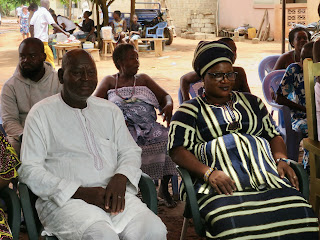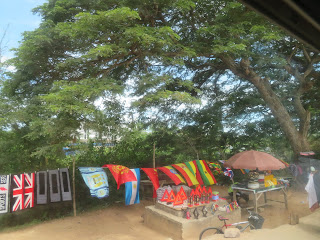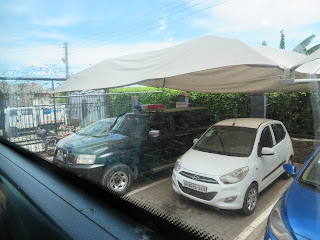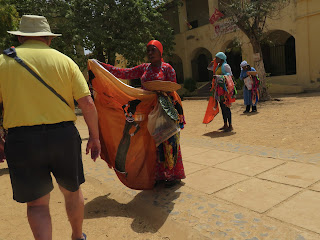Day 69 Fri Mar 24 Lome, Togo 9-7:00
Traditional Togo (LFW-006)
March 24, 2023
Port: Lome
Tour Length: Half-Day (Approximately 4 1/2 hours)
Tour Description
View a market where voodoo healers purchase ingredients for ceremonies, charms and potions. (This was interesting; voodoo dolls, masks, skulls, dead animals not skinned,)
Tour a Togolese village school to discover how rural children are educated. (We stopped there and the children came out but it was mostly pandemonium and I learned nothing. As a retired teacher, I would have been the teacher who was a nervous wreck with the situation.)
Encounter the village’s royal court and receive an introduction to the local monarch. (This was a cool experience.)
Join the monarch for a joyous folkloric performance enhanced with soul-stirring drumming.
Revel in time on your own to immerse yourself in village life. (10-15 Minutes) Experienced welcome ceremony, women’s band and dancers, royal court entry and seating, and information was shared.There were a lot of goats roaming freely. A woman was cooking in a pot over an open fire and another woman was hand washing in tubs outside her house.
Behold the distinctive African traditions of Togo by visiting a market for voodoo practitioners, touring a rural school and watching a folkloric dance with a village monarch. Enjoy a brief drive through Lomé, an engaging capital city of wide boulevards lined with colonial buildings. You’ll find that, although the country’s religion is predominately Christian, many of the people remain faithful to the religious ancestry of voodoo, which you’ll see at an open-air market frequented by traditional healers seeking ingredients for rituals or the creation of magic charms and potions. Following this compelling and rather unusual visit, travel into the countryside to a Togolese village school, where you’ll learn how rural children cope with Togo’s educational challenges. You’ll find the nearby ceremonial grounds and meet the village’s distinguished royal court, who will introduce you to the local monarch. After an enlightening presentation of tribal customs, sit with the monarch for a rousing folk dance performance accompanied by traditional rhythmic drumming. You’ll relish free time after the entertainment to explore the village, absorbing the charisma of this intriguing land.
Lome Beach Marche aux Fetishes, Cathedrale du Sacre Coeur de Lome, Monument de l’Independence, Musee International du Golfe de Guinee, Musee National du Togo, Grand Marche, Togolese Villages on TV
This tour includes approximately 90 minutes of easy-to-moderate walking/standing, plus any additional walking at the guest’s discretion during free time. There will be some uneven and natural surfaces to negotiate. Please keep in mind that you are visiting a destination where conditions and equipment may not be up to the same standards that are available in other areas of the world; however, they will be the best available. Guests who go ashore do so with the understanding that they will be mixing with members of the general public.
Togo is a narrow country in West Africa squeezed between Ghana and Benin. Lome is the capital and largest city. Togo offers an international airport, highways and trains. In 1897, it was under German control, 1919 it was under French control, and in 1960 Togo became independent.
Lome is the chief port and exports coffee, cocoa, cotton, copra, and oil palm kernels. Copra is the dried, white flesh of the coconut from which coconut oil is extracted. The oil extracted is rich in lauric acid and is used in soaps, cosmetics, etc. Lome is the country’s administrative and industrial center and has an oil refinery. The Togo National Museum is in the Palais de Congres and contains jewelry, musical instruments, dolls, pottery weapons and examples of art and traditions. Political instability since 1990.
In my opinion, this was a great welcome. The men in the back with the orange
Our first stop of the day was the Voodoo Market
Stop in to see your local witch doctor.
Our second stop was at a school.
Our third stop was with the Village Chief Women singing, playing, dancing
Welcome Ceremony
Woman cooking over an open fire.
Woman hand washing the clothing
Nancy Jacobs, this goat is for you. They roam freely in the village.



































































